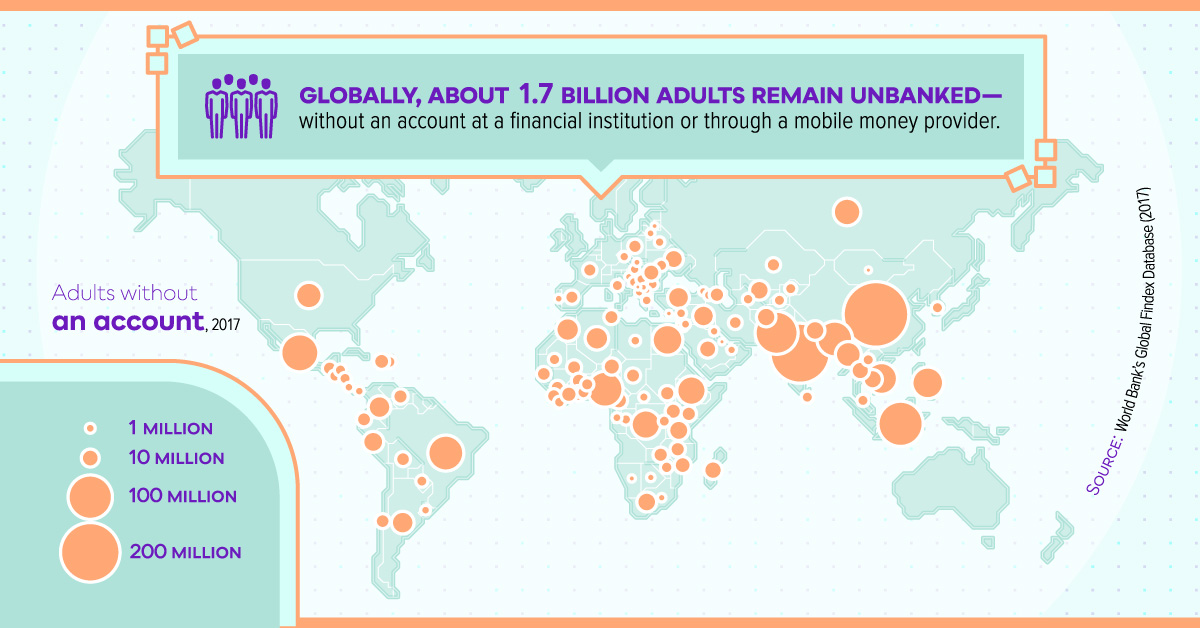Markets
The 7 Major Flaws of the Global Financial System
.container {
max-width: 1200px;
}
.button {
display: inline-block;
height: 45px;
color: #ffffff;
text-align: center;
font-family: helvetica;
letter-spacing: .01rem;
text-decoration: none;
white-space: nowrap;
border-radius: 0px;
line-height: 45px;
border: 1px;
font-size: em(13);
cursor: pointer;
box-sizing: border-box;
background: #6C1ABD;
transition-duration: 0.4s;
margin-bottom: 1px;
width: 33.33333%;
}
.button-group {
position: left;
width: 100%;
display: inline-block;
list-style: none;
padding: 0;
margin: 0;
/* IE hacks */
zoom: 1;
*display: inline;
}
.button-group li {
float: left;
padding: 0;
margin: 0;
}
.button-group .button {
display: inline-block;
box-sizing: border-box;
color: white;
}
.button-group > .button:not(:first-child):not(:last-child), .button-group li:not(:first-child):not(:last-child) .button {
border-radius: 0;
}
.button-group > .button:first-child, .button-group li:first-child .button {
margin-left: 0;
border-top-right-radius: 0;
border-bottom-right-radius: 0;
}
.button-group > .button:last-child, .button-group li:last-child > .button {
border-top-left-radius: 0;
border-bottom-left-radius: 0;
border-bottom-right-radius: 0;
}
.button:hover {
background-color: #FFA774;
}
.button.active {
background-color: #FFA774;
}
.button-group :not(:last-child) {
border-right: 1px solid white;
padding-right: 2px;
}
.button-group {
border-right: none;
margin-right: none;
}
@media (max-width: 600px) {
.button {
font-size: 13px;}
}

The 7 Major Flaws of the Global Financial System
Since the invention of banking, the global financial system has become increasingly centralized.
In the modern system, central banks now control everything from interest rates to the issuance of currency, while government regulators, corporations, and intergovernmental organizations wield unparalleled influence at the top of this crucial food chain.
There is no doubt that this centralization has led to the creation of massive amounts of wealth, especially to those properly connected to the financial system. However, the same centralization has also arguably contributed to many global challenges and risks we face today.
Flaws of the Global Financial System
Today’s infographic comes to us from investment app Abra, and it highlights the seven major flaws of the global financial system, ranging from the lack of basic access to financial services to growing inequality.
1. Billions of people globally remain unbanked
To participate in the global financial sector, whether it is to make a digital payment or manage one’s wealth, one must have access to a bank account. However, 1.7 billion adults worldwide remain unbanked, having zero access to an account with a financial institution or a mobile money provider.
2. Global financial literacy remains low
For people to successfully use financial services and markets, they must have some degree of financial literacy. According to a recent global survey, just 1-in-3 people show an understanding of basic financial concepts, with most of these people living in high income economies.
Without an understanding of key concepts in finance, it makes it difficult for the majority of the population to make the right decisions – and to build wealth.
3. High intermediary costs and slow transactions
Once a person has access to financial services, sending and storing money should be inexpensive and fast.
However, just the opposite is true. Around the globe, the average cost of a remittance is 7.01% in fees per transaction – and when using banks, that rises to 10.53%. Even worse, these transactions can take days at a time, which seems quite unnecessary in today’s digital era.
4. Low trust in financial institutions and governments
The financial sector is the least trusted business sector globally, with only a 57% level of trust according to Edelman. Meanwhile, trust in governments is even lower, with only 40% trusting the U.S. government, and the global country average sitting at 47%.
5. Rising global inequality
In a centralized system, financial markets tend to be dominated by those who are best connected to them.
These are people who have:
- Access to many financial opportunities and asset classes
- Capital to deploy
- Informational advantages
- Access to financial expertise
In fact, according to recent data on global wealth concentration, the top 1% own 47% of all household wealth, while the top 10% hold roughly 85%.
On the other end of the spectrum, the vast majority of people have little to no financial assets to even start building wealth. Not only are many people living paycheck to paycheck – but they also don’t have access to assets that can create wealth, like stocks, bonds, mutual funds, or ETFs.
6. Currency manipulation and censorship
In a centralized system, countries have the power to manipulate and devalue fiat currencies, and this can have a devastating effect on markets and the lives of citizens.
In Venezuela, for example, the government has continually devalued its currency, creating runaway hyperinflation as a result. The last major currency manipulation in 2018 increased the price of a cup of coffee by over 772,400% in six months.
Further, centralized power also gives governments and financial institutions the ability to financially censor citizens, by taking actions such as freezing accounts, denying access to payment systems, removing funds from accounts, and denying the retrieval of funds during bank runs.
7. The build-up of systemic risk
Finally, centralization creates one final and important drawback.
With financial power concentrated with just a select few institutions, such as central banks and “too big too fail” companies, it means that one abject failure can decimate an entire system.
This happened in 2008 as U.S. subprime mortgages turned out to be an Achilles Heel for bank balance sheets, creating a ripple effect throughout the globe. Centralization means all eggs in one basket – and if that basket breaks it can possibly lead to the destruction of wealth on a large scale.
The Future of the Global Financial System?
The risks and drawbacks of centralization to the global financial system are well known, however there has never been much of a real alternative – until now.
With the proliferation of mobile phones and internet access, as well as the development of decentralization technologies like the blockchain, it may be possible to build an entirely new financial system.
But is the world ready?
Commodities
Ranked: The Countries Most Dependent on Agricultural Exports
Which countries are most heavily dependent on agricultural exports to fuel their economies? We visualize the data in this chart.

Ranked: The Countries Most Dependent on Agricultural Exports
This was originally posted on our Voronoi app. Download the app for free on iOS or Android and discover incredible data-driven charts from a variety of trusted sources.
Between 2019 and 2021, agricultural products accounted for more than one-third of the total value of global commodity exports. This graphic ranks the most agriculturally-export-dependent countries in the world, using data from UN Trade & Development (UNCTAD).
For this graphic we have only included countries where agricultural products represent more than 75% of its total exports. Resource dependency can make a country vulnerable to economic shocks via price fluctuations.
Ranked: Countries that Rely Heavily on Agricultural Exports
In Micronesia, a staggering 98% of all its exports are agricultural, of which 89% are fish in various forms. In fact, five of the top 10 countries are small island nations in the Pacific. Four of them also have fish as their top agricultural export.
Below is a more extensive list showing countries whose agricultural products make up more than 60% of their total exports. Also listed: their most-valued agriculture export in 2022, sourced from the Observatory of Economic Complexity.
| Rank | Country | % of Merchandise Exports From Agriculture | Top Agricultural Export (2022) |
|---|---|---|---|
| 1 | 🇫🇲 Micronesia | 98% | 🐟 Fish |
| 2 | 🇬🇼 Guinea-Bissau | 94% | 🌰 Cashew Nuts |
| 3 | 🇲🇼 Malawi | 93% | 🚬 Raw Tobacco |
| 4 | 🇸🇧 Solomon Islands | 89% | 🌲 Rough Wood |
| 5 | 🇲🇻 Maldives | 88% | 🐟 Fish |
| 6 | 🇻🇺 Vanuatu | 86% | 🐟 Fish |
| 7 | 🇰🇮 Kiribati | 84% | 🐟 Fish |
| 8 | 🇹🇴 Tonga | 82% | 🐟 Fish |
| 9 | 🇺🇾 Uruguay | 79% | 🐄 Bovine Meat |
| 10 | 🇪🇹 Ethiopia | 77% | ☕ Coffee |
| 11 | 🇳🇿 New Zealand | 77% | 🥛 Milk |
| 12 | 🇦🇷 Argentina | 76% | 🌱 Soybean Meal |
| 13 | 🇬🇲 Gambia | 75% | 🥜 Groundnuts |
| 14 | 🇧🇿 Belize | 75% | 🍬 Sugar |
| 15 | 🇼🇸 Samoa | 69% | 🥥 Coconut Oil |
| 16 | 🇵🇾 Paraguay | 68% | 🌱 Soybeans |
| 17 | 🇨🇮 Côte d'Ivoire | 67% | 🍫 Cocoa Beans |
| 18 | 🇸🇴 Somalia | 67% | 🐑 Sheep & Goats |
| 19 | 🇦🇫 Afghanistan | 65% | ☁️ Raw Cotton |
| 20 | 🇸🇾 Syria | 63% | 🫒 Pure Olive Oil |
| 21 | 🇸🇩 Sudan | 62% | 🌿 Sesame Seeds |
| 22 | 🇧🇯 Benin | 61% | ☁️ Raw Cotton |
| 23 | 🇨🇫 Central African Republic | 60% | 🌲 Rough Wood |
Maldives, in the Indian ocean, is also within the top 10. Its top agricultural export is also fish. Interestingly, the Observatory of Economic Complexity states “Planes, Helicopters, and Spacecraft” as Maldives’ top overall export in 2022 ($433M). However, it’s possible that this might be a case of re-exportation.
Aside from fish, various kinds of nuts and edible oils are also popular categories of agricultural exports.
Regionally, these agricultural-export-dependent countries are spread between Asia, Oceania, Africa, and South America. Europe and North America are not represented in this list.
There are also correlations between resource export dependency and economic maturity. The UN found that 67% of the world’s developing nations were resource-export-dependent in some way: between agriculture, energy, and mining.
-
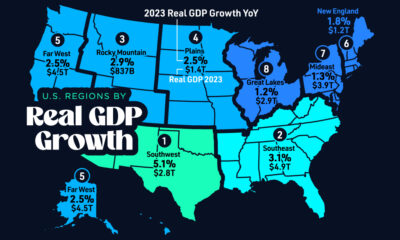
 United States6 days ago
United States6 days agoMapped: The Real GDP Growth of U.S. Regions in 2023
-

 Technology2 weeks ago
Technology2 weeks agoWhat Laptop Brands do Americans Use in 2024?
-
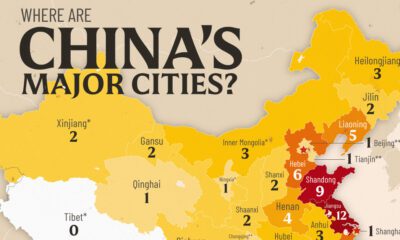
 Maps2 weeks ago
Maps2 weeks agoMapped: Chinese Provinces With Cities Over 1 Million People
-

 Best of2 weeks ago
Best of2 weeks agoBest Visualizations of May on the Voronoi App
-

 Crime2 weeks ago
Crime2 weeks agoVisualizing the Companies Online Scammers Impersonate the Most
-

 Stocks2 weeks ago
Stocks2 weeks agoComparing Saudi Aramco’s $1.9T Valuation to Its Rivals
-
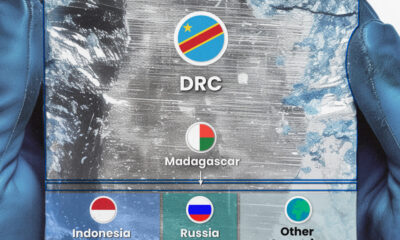
 Mining1 week ago
Mining1 week agoVisualizing Cobalt Production by Country in 2023
-
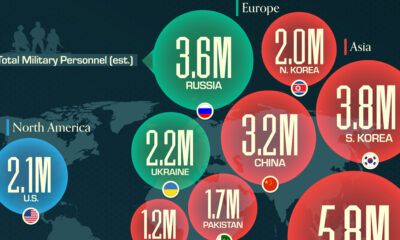
 War1 week ago
War1 week agoMapped: The World’s Largest Armies in 2024

